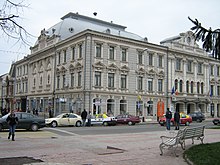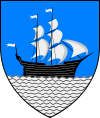Brăila
Brăila | |
|---|---|
 Brăila Auld Toun, nicht view | |
 Location o Brăila | |
| Coordinates: 45°16′09.1″N 27°57′26.9″E / 45.269194°N 27.957472°E | |
| Kintra | |
| Coonty | Brăila Coonty |
| Status | Coonty caipital |
| Govrenment | |
| • Mayor | Aurel Gabriel Simionescu (Social Democratic Pairty) |
| Area | |
| • Total | 77.9 km2 (30.1 sq mi) |
| Elevation | 25 m (82 ft) |
| Population (2011 census)[1] | |
| • Total | 180,302 |
| • Density | 5071/km2 (13,130/sq mi) |
| Time zone | UTC+2 (EET) |
| • Summer (DST) | UTC+3 (EEST) |
| Postal code | 810xxx |
| Area code(s) | (+40) 239 |
| Vehicle registration | BR |
| Website | http://www.primariabraila.ro/ |
Brăila (Romanie pronunciation: [brəˈila] (![]() listen); Greek: Μπράιλα; Turkis: İbrail) is a ceety in Muntenie, eastren Romanie, a port on the Danube an the caipital o Brăila Coonty. It is locatit in the close vicinity o Galaţi. The Sud-Est Regional Development Agency is locatit in Brăila.
listen); Greek: Μπράιλα; Turkis: İbrail) is a ceety in Muntenie, eastren Romanie, a port on the Danube an the caipital o Brăila Coonty. It is locatit in the close vicinity o Galaţi. The Sud-Est Regional Development Agency is locatit in Brăila.
Accordin tae the 2011 Romanie census thare wur 180,302 fowk livin athin the ceety o Brăila,[1] makkin it the 11t maist populous ceety in Romanie.
History
[eedit | eedit soorce]

A dounset at this location on the left bank o the Danube, in Wallachie, wis mentioned wi the name Drinago in a Spainyie Libro de conoscimiento ("Beuk o knawledge", circa 1350) an in several Catalan portolan chairts (Angelino de Dalorto, 1325/1330 an Angelino Dulcert, 1339). This mey hae been an erroneous transcription o Brillago. In Greek documents o roughly that time, the ceety is referred tae as Proilabum or Proilava, a Greek leid adaptation o its Slavic name, Brailov. In German leid sources, it is mentioned as Uebereyl. The oreegin an meanin o the name is unkent.
As a kaza, the toun an its surroondin aurie wis controlled bi Ottoman Turks frae 1538–1540 until 1829 (it wis restored tae Wallachia through the Akkerman Convention); the Ottomans cried it Ibrail or Ibraila.
Brăila wis attackit, plundered, an set fire tae bi the forces o Moldavie Prince Stephen the Great on 2 Februar 1470, durin the retaliation campaign against Wallachie Prince Radu the Fair, who haed alleed hissel wi the Ottomans. It wis briefly ruled bi Michael the Brave, prince o Wallachie (1595–1596).
Durin the 19t century, the port became ane o the three maist important ports on the Danube in Wallachie, the ither twa bein Turnu an Giurgiu. The ceety's greatest period o prosperity wis at the end o the 19t century an in the early 20t century, when it wis a important port for maist o the merchandise comin in an goin oot o Romanie.
Demographics
[eedit | eedit soorce]| Historical population of Brăila | |||||||||||||
| Year | Population | %± | |||||||||||
|---|---|---|---|---|---|---|---|---|---|---|---|---|---|
| 1900 | 58,392[2] | — | |||||||||||
| 1912 census | 65,053[3] | 11.4% | |||||||||||
| 1930 census | 68,347 | 5% | |||||||||||
| 1948 census | 95,514 | 39.7% | |||||||||||
| 1956 census | 102,500 | 7.3% | |||||||||||
| 1966 census | 138,802 | 35.4% | |||||||||||
| 1977 census | 194,633 | 40.2% | |||||||||||
| 1992 census | 234,110 | 20.2% | |||||||||||
| 2002 census | 216,292 | −7.6% | |||||||||||
| 2011 census | 180,302 | −16.6% | |||||||||||
As o 2011 census data (est.), Brăila haes a population o 180,302, a decrease frae the figur recordit at the 2002 census.[1] The ethnic makup wis as follaes:
Metropolitan aurie
[eedit | eedit soorce]Economy
[eedit | eedit soorce]Accessible tae smaw an middlin-sizit oceangoin ships, Brăila haes lairge grain-handlin an warehoosin facilities. It is a important industrial centre an aw, wi metalwirkin, textile, fuid-processin, an ither factories.
Ceetyscape
[eedit | eedit soorce]Brăila haes the follaein auries: Centru (Center), Viziru (1, 2, 3), Călăraşi 4, Ansamblul Buzăului, Radu Negru, Obor, Hipodrom, Lacu Dulce, Dorobanți, 1 Mai, Comorofca, Calea Galați, Gării, Apollo, Siret, Pisc, Brăilița, Vidin-Progresul, Islaz an Chercea.
Landmarks
[eedit | eedit soorce]

Streets radiating frae near the port towards Brăila's center are crossed at symmetrical intervals bi concentric streets following the geometric design of the auld Ottoman fortifications.
The auld centre o the ceety haes mony 19t century biggins, some o thaim fully restored. The maist important monuments are the Greek Church, erected at 1865 bi the Greek commonty, the Sfinţii Arhangheli Kirk, umwhile jāmi durin the Ottoman rule (till 1831), the 19t century Sfântul Nicolae Kirk, frae the 19t century an aw, the Maria Filotti Theatre, the Palace o Cultur an its Airt Museum, the History Museum, an the auld Watter Touer. The latter hooses a restaurant an a rotation seestem (360° in ane oor).
Anither important steid is the Public Garden, a pairk situatit abuin the bank o the Danube wi a view ower the river an the Măcin Muntains. Early in 2006 the municipality receivit European Union funds tae renovate the auld centre o the ceety, aimin tae transform Brăila intae a major tourist attraction o Muntenia.
The Kirk o the Holy Airchangels is the auldest in the ceety. Begun in 1667, the umwhile mosque wis transformit intae an Orthodox Kirk in 1808.
Transport
[eedit | eedit soorce]Brăila features ane o the auldest electrical tram lines in Romanie, inauguratit at the end o the 19t century an still in uise. Brăila's bus seestem is operatit bi the toun haw in cooperation wi Braicar Company, wi fower primar bus configurations available servicin maist o the ceety.
Local media
[eedit | eedit soorce]The ceety haes several local newspapers, includin Obiectiv-Vocea Brăilei, Monitorul de Brăila, Ziarul de Brăila an Arcașu'. It haes three telly stations an aw: Mega TV, an the local stations of Antena 1 an Pro TV.
Internaitional relations
[eedit | eedit soorce]Twin touns - sister ceeties
[eedit | eedit soorce]Brăila is twinned wi:
 Pleven in Bulgarie.
Pleven in Bulgarie. Calais in France.
Calais in France. Argostoli in Greece.
Argostoli in Greece. Katerini in Greece.
Katerini in Greece. Bitola in Macedonie.
Bitola in Macedonie. Kavadarci in Macedonie.
Kavadarci in Macedonie. Denizli in Turkey.
Denizli in Turkey. Nilüfer in Turkey.
Nilüfer in Turkey.
Freemit airtins
[eedit | eedit soorce]| Wikimedia Commons haes media relatit tae Brăila County. |
Notes
[eedit | eedit soorce]- ↑ a b c "Population at 20 October 2011" (in Romanian). INSSE. 5 Julie 2013. Archived frae the original on 26 December 2018. Retrieved 5 Julie 2013.CS1 maint: unrecognised leid (link)
- ↑ Encyclopædia Britannica Eleventh Edition
- ↑ A Handbook of Roumania
| Wikimedia Commons haes media relatit tae Brăila. |


